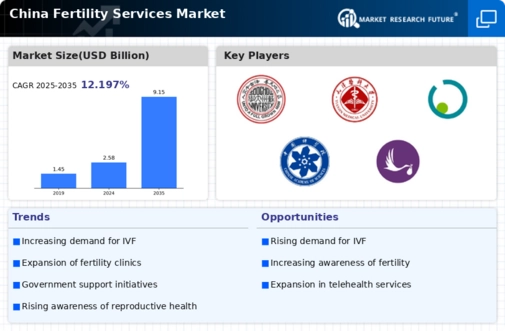Market Trends
Key Emerging Trends in the China Fertility Services Market
The China pregnancy Services market is becoming more aware of and open to these changes as people's ideas about pregnancy problems begin to shift. Being open about sexual health is making more people and couples want to use fertility services to help them plan their children. In China, more and more people are putting off having children, which is making more people need fertility services. Because they want to go to college, get ahead at work, or move, a lot of people are putting off having kids. To put it another way, they need help getting pregnant. China has taken steps to help women who are having trouble giving birth because it knows that having too many people can be a problem. The market is being shaped by rules and prizes to get more people to have children. Changes are also being made to the law to help fertility service companies grow. Inside-cell sperm injection (ICSI), preimplantation genetic testing (PGT), and in vitro fertilization (IVF) are some of the assisted reproductive technologies that are quickly growing in the China Fertility Services market. These tools have made more methods work, which gives women more ways to get pregnant. More and more people are having trouble getting pregnant because of things in their surroundings or changes in their lifestyle, like stressing more and working out less. People want fertility services that take into account both medical and social problems that have a bigger effect on sexual health in order for this to happen. There are more and more services that freeze and store eggs because people are putting off having kids. Women who pay for these services want to be able to have children at a younger age. As they age, it gets harder for them to have babies. It's good for the market that China is getting more baby centers and other specialized places. There are more and more companies from inside and outside the country getting into the fertility business as the need for all-around options grows. The market is changed by the fact that more people know about issues with men getting pregnant. Men go to fertility services to get checked out and given care. This is a part of a bigger plan to help both men and women who are having trouble getting pregnant. More and more fertility companies are using online and digital health choices. More and more people are using apps that keep track of pregnancy, hold meetings online, and keep an eye on things from afar. More people can get fertility care because these choices make it easy for them to do so. The way pregnant women in China get help has changed over the years. Fertility services are becoming more popular as a way to plan a family because fewer people feel bad about not being able to have children. People are going on vacation to China and getting pregnant while they are there. Fertility centers in China and other countries have agreements and ties that make it easy for experts to share what they know and the best ways to do things. There are now more options for people who want to get pregnant. Things are getting better, but cost and access are still problems. Many people and couples have trouble getting the help they need to get pregnant. To help a lot more people use birth control, these problems need to be fixed.








Leave a Comment